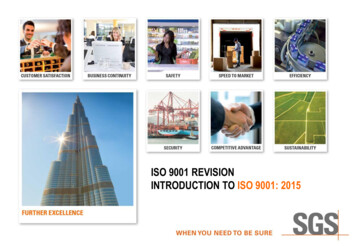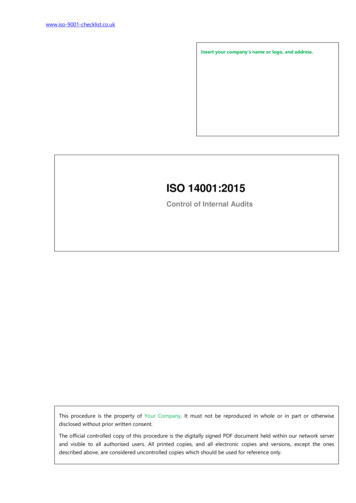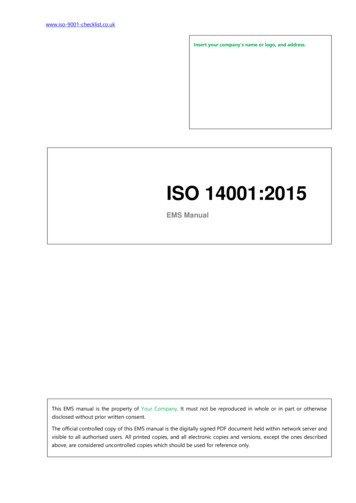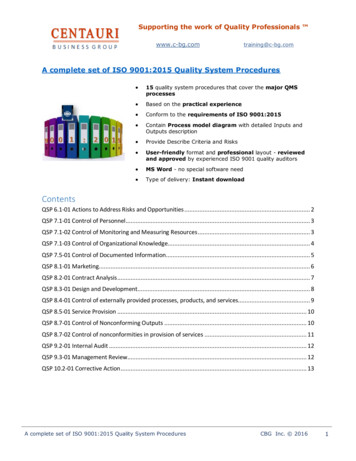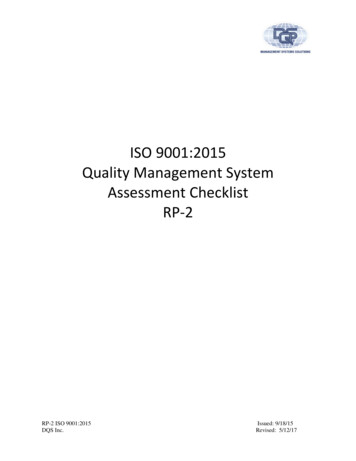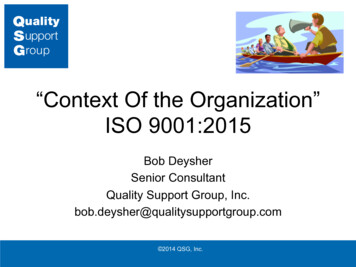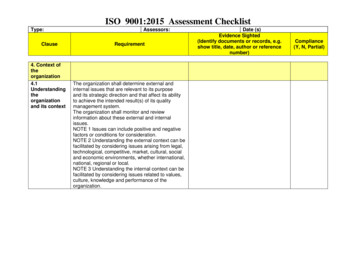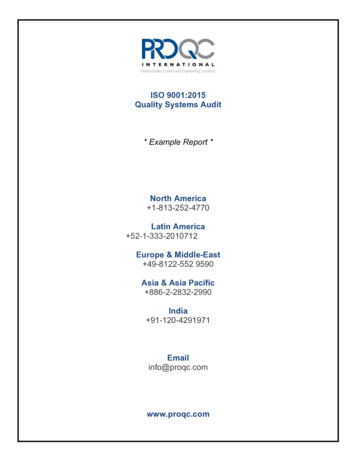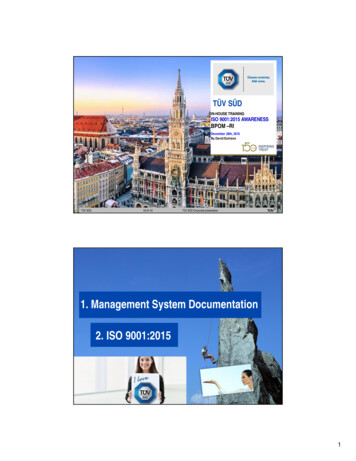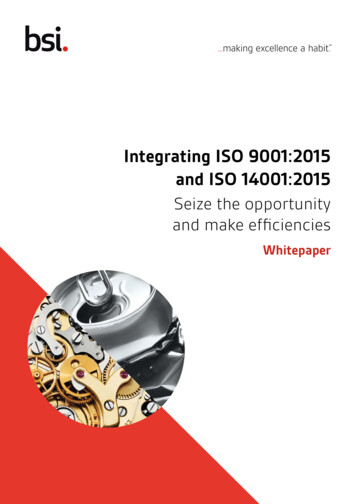
Transcription
Integrating ISO 9001:2015and ISO 14001:2015Seize the opportunityand make efficienciesWhitepaper
Integrating ISO 9001 and ISO 14001:there’s no better timeWhy now? ISO standards have changed. The introduction of Annex SL, or highlevel structure (HLS), has changed the approach to designing managementsystems. Standards using the HLS all have 10 common clauses.Previously, management systems hadvery different structures so the resultingsystems could not be easily merged.When organizations have multiple,disparate systems in place theyduplicate the time, effort and resourcesrequired. With Annex SL in place moreorganizations can benefit from aligningseparate systems with the HLS.Clause 1 – ScopeClause 6 – PlanningClause 2 – Normative referencesClause 7 – SupportClause 3 – Terms and definitionsClause 8 – OperationClause 4 – Context of the organizationClause 9 – Performance evaluationClause 5 – LeadershipClause 10 – ImprovementThe result of combining two systemslike ISO 9001 and ISO 14001 is anintegrated management system (IMS).An IMS is typically characterized by the following:Anything that affects business resultsis part of one management systemand all processes and documentationare fully integrated. As many partsof an organization participate in thedevelopment, implementation andmaintenance of management systems,having one system reduces theamount of time and effort needed tofulfil the requirements of each phase.2. Management reviews that consider the overall business strategy and plan;1.An integrated documentation set, including work instructions to a goodlevel of development, as appropriate;3. An integrated approach to internal audits;4. An integrated approach to policy and objectives;5. An integrated approach to systems processes;6. An integrated approach to improvement mechanisms, (corrective andpreventive action; measurement and continual Improvement); and,7.Integrated management support and responsibilities.Converge or Merge? Integrating ISO 9001 andISO 14001There are two ways to integrate these two managementsystems. If you have a certified quality management systemin place, you can converge an environmental system withit by adding the necessary processes to cater for EMSrequirements. Or you can merge systems which resultsin combining all documentation that supports thesame process.2Integrating ISO 9001:2015 and ISO 14001:2015
Opportunities for efficienciesIn this section we look at Annex SL and the main clauses of each standard to show how they might helporganizations to make savings and efficiencies by taking an integrated approach.Clause 4: Context of the organizationThis clause is concerned with identifying needs of stakeholdersand “interested parties” relevant to an organization’s EMSor QMS. Although there may be interested parties who arerelevant to one specific management system, some may berelevant to both standards. An integrated approach could helpavoid duplication if the clause was approached by both qualityand environmental teams together.Clause 4.4 is more substantial in ISO 9001 as it requiresmeasurement of the QMS as well as referring to the use of“documented information” to support this. The approachto be followed for ISO 9001 and ISO 14001 is similar andso when considering an integrated management system,documentation efficiencies could be achieved by taking aconsistent approach to this clause.Clause 5: LeadershipTop management is required to take a greater role inthe revised versions of both standards and they need todemonstrate that the respective standard is aligned withthe strategic direction of their organization. In both ISO9001 and ISO 14001 they must give support and resources,and ensure that the importance of an effective QMS/EMSis communicated. It makes sense for top management tosupport these two management systems in an integrated wayas efficiencies could be achieved which could which could freeup their time.Clause 6: PlanningThis is all about identifying risks and opportunities and bothstandards are now more explicit than previous versions aboutthe use of risk based thinking. When considering the risks andopportunities relevant to a QMS or EMS, efficiencies could beachieved through taking an integrated approach. Alignment ofrisk registers is one area where organizations are starting tosee the benefits as this has led to a reduction in paperwork.Clause 7: SupportThis is all about ensuring the resources for a QMS/EMS andmaking sure that this information is appropriately stored andcommunicated. Clause 7.1 is considerably more substantivein ISO 9001 than in ISO 14001 as this focusses on some keyareas relevant for an effective QMS where consistency andquality of products or services is required. Areas such asmeasurement, traceability, and calibration are all containedhere in ISO 9001.There are some there are some significant areas ofcommonality in the two standards including, competency,awareness, and communication. In both standards clause 7.5covers the management of “documented information”, one ofthe new terms used in the new standards. Similar documentmanagement practices can be applied to the running of thetwo standards which can help streamline processes.Clause 8: OperationClause 8 contains some significant, yet logical differencesbetween the two standards so there is less opportunity forstreamlining. Much of this clause in ISO 14001 deals withareas relevant to an environmental management system suchas emergency preparedness and the new requirement toconsider “lifecycle perspective”. In contrast ISO 9001 has animportant focus on customer requirements and the designand development of products and services. Both standardsrecognize the increased use of outsourced functions requiringthe impact of this to be considered.Clause 9: Performance evaluationThis is all about keeping the organization on track with therequirements of each standard. There are some importantdifferences, particularly in clause 9.1. Here, ISO 14001 dealswith measuring environmental performance including issuesrelated to compliance, whilst ISO 9001 concentrates onmeasuring the effectiveness of the QMS including a focus onensuring customer satisfaction.However the remainder of the clause does offer potentialefficiencies for those considering an integrated approach.Both standards have a requirement for internal audit and fora management review. As neither standard is prescriptiveabout the frequency of these it’s an excellent opportunity tocombine some or all of the elements of these which couldoffer considerable time savings.Clause 10: ImprovementThis clause is all about identifying opportunities to makethe QMS/EMS better. It also introduces requirements fordealing with no-conformities and corrective actions.Although each standard focuses on its own subjectarea, there may be opportunities to make efficienciesby adopting a consistent approach to managing theprocesses, the way these areas are handled, and the waythey are documented.Integrating ISO 9001:2015 and ISO 14001:20153
ISO 9001:2015 – At a glanceAs the world’s most recognized qualitymanagement system standard, ISO9001 is helping businesses of all sizesto save money, increase profits, winmore business and meet customerexpectations.Designed to help organizationscontinually monitor and managequality across all their operations, thisinternationally recognized standardsets the benchmark to achieveconsistent performance and service.With ISO 9001 in place, organizationscan: Motivate, empower and engagestaff with more efficient internalprocesses Become more consistentcompetitors in the marketplace Meet present and identify futurecustomer needsOffer better customer service andwin more high value customers asa result Broaden business opportunities bydemonstrating compliance. Improve lifecycle managementwhich helps to identify productimprovements Improves corporate responsibilityto meet supply chain requirements Demonstrate compliance to expandbusiness opportunities Confidently prepare for thechanging business landscape. Increase efficiency to save time,money and resourcesISO 14001:2015 at a glanceRecognized around the globe, ISO14001 helps organizations to reducetheir environmental impact whilegrowing their business – ultimatelyachieving sustainable success.As an internationally acceptedstandard, ISO 14001 outlinesthe most effective ways to puta successful environmentalmanagement system (EMS) in place.The standard was developed to helporganizations remain commerciallysuccessful without overlooking theirenvironmental responsibilities. Its highlevel framework allows businessesto meet increasingly demandingexpectations from customersand other stakeholders, as well asregulatory requirements. WithISO 14001 in place, organizations can: Improve environmentalperformance and reduce wasteIntegrating ISO 9001:2015 and ISO 14001:20154
What are the benefits of integrating ISO 9001and ISO 14001?There are many advantages for organizations, including:Improved business performanceReduced documentation and duplicationAnnex SL makes it easier tointegrate multiple managementsystems thereby gaining greaterbusiness benefits. It ensuresall business processes for bothquality and environmentalperformance are integrated andaligned with the business strategies of the organization,making it easier to continually improve all managementsystems.By meeting all the standardrequirements with one setof policies and procedures,integrating both ISO 9001 andISO 14001 will highlightoverlapping responsibilities orunnecessary duplication. This willresult in less duplication whichmakes business processes easier to manage and maintain.A holistic approachSave time and resourcesIntegrating multiple managementsystem standards providesa more holistic approach tobusiness processes whichincreases efficiency, developscoordinated solutions to problemsin different work areas, andprovides a complete view of the whole organization. Thisstrategic focus will result in optimizing the performanceof both management systems and drive real value in theorganization.Position quality and sustainability into theheart of the organizationThe revised standards ensurethat quality and environmentalmanagement are now completelyintegrated with the businessstrategies of the organization.Used as a business managementtool, this will embed healthyperformance improvement processes over time andpromote the importance of both quality and environmentalrequirements at the same time.With an integrated managementsystem the audit process - bothinternally and externally - willbe more effective resulting indecreased disruption, eliminatingduplication of audit activity andsaving time, money and otherresources.Improved risk and opportunity managementUsing risk-based thinkingthroughout, the revised standardspromote a proactive approachto identifying risks and takingopportunities, making continualimprovement systematic. Thiswill lead to improved governanceand decision making acrossboth quality and environmentalmanagement.Integrating ISO 9001:2015 and ISO 14001:20155
Next stepsNow that the revised versions ofISO 9001 and ISO 14001 havebeen published, it’s an ideal time tointegrate your management systemstogether into one set of policies andprocedures.To find out moreabout BSI’s solutionsto help you with thenew ISO changesvisit: bsigroup.comOur products and servicesWe provide a unique combination of complementary products and services, managedthrough our three business streams; Knowledge, Assurance and Compliance.KnowledgeComplianceBSI works with business experts, government bodies, tradeassociations and consumer groups to capture best practiceand structure the knowledge all organizations need tosucceed. The majority of the widely used and implementedinternational standards were originally shaped by BSI, forexample ISO 14001, Environmental Management and ISO/IEC 27001 for Information Security.To experience real, long-term benefits, our clients need toensure ongoing compliance to a standard so that it becomesan embedded habit. We train our clients to understandstandards and how to implement them, as well as provideadded value and differentiated management tools to facilitatethe process of ongoing compliance.AssuranceTo find out morevisit: bsigroup.combsigroup.com BSI GroupBSI/UK/778/SC/0116/EN/BLDIndependent assessment of the conformity of a process orproduct to a particular standard ensures that our clientsperform to a high level of excellence. We help our clientsunderstand how they are performing, thereby identifyingareas of improvement from within.
ISO 9001:2015 – At a glance As the world’s most recognized quality management system standard, ISO 9001 is helping businesses of all sizes to save money, increase profits, win more business and meet customer expectations. Designed to help organizations continually monitor and manage quality across all their operations, this internationally recognized standard sets the benchmark to achieve .
